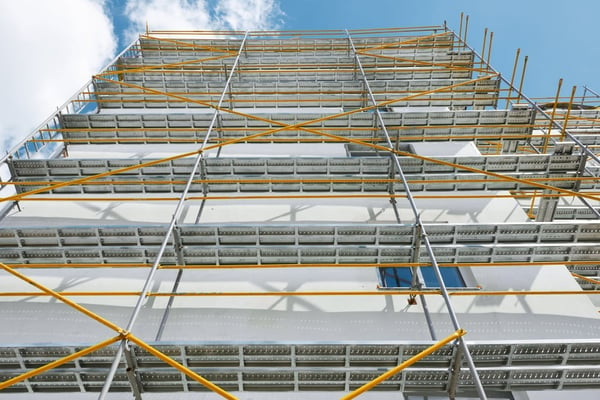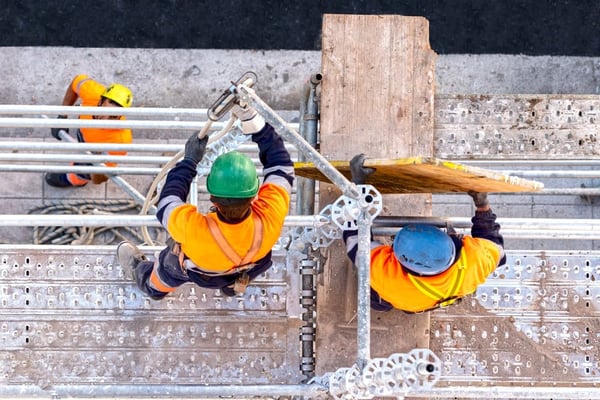Performing work at height on site will typically require the use of scaffolding. The safe installation of scaffolding is vital to ensuring a safe site, as there are inherent risks associated with materials at an elevated position (such as scaffolding elements themselves, or tools), or for workers to fall themselves. Here we profile the trade and guide you on the safe use of scaffolding for your next job.
What is scaffolding?
By definition, scaffolding is a temporary structure that is erected to enable access to elevated site positions or to create a platform for work to be safely conducted.
What is scaffolding used for?
The majority of construction jobs require scaffolding, whether they are new builds, demolitions, renovations or smaller-scale repairs. If the task being undertaken is above ground level, it would not only be unsafe to operate without suitable scaffolding but highly impractical as well. There are a number of types of scaffolding, but the main ones include:
- Supported scaffolding: the most common type that people associate with a construction job. The structure is built from the ground up to the side of a building and is typically made from metal tubes and couplers. This is a highly flexible method that allows the addition of levels (for builds) or their removal (for demolition) as required and is also very sturdy.
- Mobile scaffolding: also known as rolling scaffolding, it is erected in the same way as supported scaffolding but is mounted on castors and is freestanding. Often utilised on large building sites with multiple worksites, as it can be repositioned and negates the need for regular dismantling and reconstruction.
- Suspended scaffolding: utilised when working on very tall buildings and where supported or mobile scaffolding would be impractical. The scaffolding is suspended from the roof of the building and can be raised or lowered to different levels of the building as required. This method is often employed for window cleaning or to move tools and equipment between levels.
What do scaffolders do?

Scaffolders assemble and dismantle temporary structures or platforms at a variety of work sites. Elements of their role include:
- Assessing plans and blueprints to select the appropriate scaffolding materials
- Fitting the selected materials together safely, lifting and positioning them on site
- Disassembling the structure upon completion of the job and ensuring the site is left neat and tidy
Scaffolders might be working at a number of different site locations, such as construction, music or entertainment sites. They need to have a strong working knowledge of scaffolding safety requirements and a high-risk work license. The work can be physically demanding and requires individuals to be comfortable working at heights, outdoors and in varying weather conditions.
Is scaffolding a dangerous job?
If performed safely and in accordance with approved techniques that a Registered Training Organisation (RTO) teaches, scaffolding does not need to be a dangerous job, However, poorly planned structures, the use of inferior materials or the construction of scaffolding by anyone other than an untrained professional can make it a highly dangerous job (and equally dangerous for anyone else utilising the scaffolding).
Safe Work Australia confirm that 48 workers were killed from “falls from heights” between the five years from 2008 to 2013. Of these, 20 deaths were falls from buildings, 12 were falls from ladders and 5 were falls from scaffolding.
What are some safety precautions for scaffolding?
There are a number of safety precautions that should be considered to avoid scaffolding hazards on your next job.
These include:
Installation by a trained scaffolder
Worker safety should never be left to chance and this is especially the case when dealing with the hazards that height can present. Always ensure your scaffolding has been designed, installed, managed, moved and disassembled by a qualified scaffolder. If the finished structure will result in a potential fall of a person or object of four metres or more, then a scaffolding high-risk work license is required.
Training workers on scaffolding use
Invest the time to ensure that any workers who will be working on the scaffolding are thoroughly trained on how to do so. This includes accessing and scaling the scaffolding, use of materials on the scaffolding and the rated load capacity. Training should also cover awareness of hazards such as electrocution, falling objects, worker falls and the procedures to deal with these.Regular inspection of the structure
In addition to inspection when the structure is initially erected, ensure it is regularly reviewed for structural integrity if it is in place for a significant period of time. With the motion and load that workers, tools and equipment create, it is important to ensure the structure remains robust and no elements have been displaced or compromised.Foster a “safety first” approach to scaffold use
While much of it is common sense, ensure that workers understand the below guidelines and feel empowered to report any breaches:- Remove all materials or tools from a working platform at the end of a shift
- Never use items such as boxes or ladders to increase their working height
- Never overload the structure beyond what it is rated to hold
- Never work on the structure if it appears damaged or compromised
- Never climb on elements of the structure that were not intended for it (such as handrails)
Ensure personal protective equipment is worn
While the structure, by definition, is designed to keep workers safe, it must not be at the exclusion of personal protective equipment. Ensure all workers are wearing a hard hat (whether on, around or under the structure) and non-skid work boots, Also consider utilising tool lanyards and fall arrest systems for additional safety.Watch the weather
Conditions can change dramatically over the course of a shift, so ensure you keep an eye on the skies and shut down work if inclement weather hits. This includes high winds, rain, sleet and even snow, pending where you are working. Ensure that all debris is removed from working platforms after a bout of bad weather before workers re-enter the structure.
Can you use a ladder on scaffolding?
Freestanding ladders should not be used when working on scaffolding. Depending on the type of scaffolding structure that has been built, there might be a fixed ladder, built-in ladder or even access stairway to enable workers to access different levels. These are part of the designed structure and are fine for workers to use. The general rule of thumb is that if additional height is needed, then your trained scaffolder should modify the structure to safely give you the required access to where you need to perform your next task.
How long can scaffolding be left up?

While there are no set scaffolding standards regarding how long it can be left up, the guidance is that it should be as long as practicable for all project tasks requiring the structure to be safely completed. There are, however, a few points to note about inspecting a scaffolding structure which encompasses this, which state that a competent person must inspect the structure:
- Before it is used for the first time
- Before it is used again after an incident that might impact its stability
- Before it is used after repairs
- At least every 30 days


